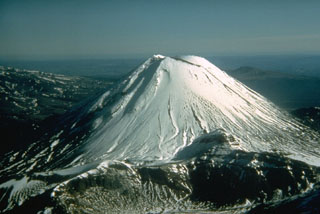Report on Tongariro (New Zealand) — May 1995
Bulletin of the Global Volcanism Network, vol. 20, no. 5 (May 1995)
Managing Editor: Edward Venzke.
Tongariro (New Zealand) No fumarolic activity in Ngauruhoe crater or deformation
Please cite this report as:
Global Volcanism Program, 1995. Report on Tongariro (New Zealand) (Venzke, E., ed.). Bulletin of the Global Volcanism Network, 20:5. Smithsonian Institution. https://doi.org/10.5479/si.GVP.BGVN199505-241080
Tongariro
New Zealand
39.157°S, 175.632°E; summit elev. 1978 m
All times are local (unless otherwise noted)
Extremely low activity levels were found during an annual crater inspection and deformation survey on 11 May in the crater and at the base of Ngāuruhoe. Crater fumaroles failed to discharge gases: the first complete absence of activity ever previously reported there. However, the NE rim of the outer crater was steaming vigorously as in the past. Neither horizontal nor vertical deformation were of sufficient magnitude to suggest volcanic significance. The current level of crater activity is probably the lowest in recorded history.
Ngāuruhoe is the highest and most recent of more than a dozen composite cones that comprise the large Tongariro volcanic massif N of Ruapehu. Ten years ago, in February 1975, Ngāuruhoe produced its last eruption, an event that generated 10-km-high plumes and pyroclastic flows. In 1983 several seismic swarms were recorded.
Geological Summary. Tongariro is a large volcanic massif, located immediately NE of Ruapehu volcano, that is composed of more than a dozen composite cones constructed over a period of 275,000 years. Vents along a NE-trending zone extending from Saddle Cone (below Ruapehu) to Te Maari crater (including vents at the present-day location of Ngauruhoe) were active during several hundred years around 10,000 years ago, producing the largest known eruptions at the Tongariro complex during the Holocene. North Crater stratovolcano is truncated by a broad, shallow crater filled by a solidified lava lake that is cut on the NW side by a small explosion crater. The youngest cone, Ngauruhoe, is also the highest peak.
Information Contacts: P.M. Otway, Institute of Geological and Nuclear Sciences (IGNS), Private Bag 2000, Wairakei, New Zealand.

